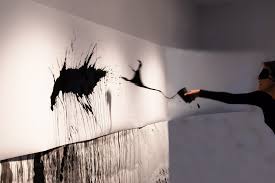Weird Chinese Painters April 17, 2016
Author: Beach Combing | in : Medieval , trackback
Modern painters have used blood and vomit as paints and penis, breasts and even eyes as brushes. However, the medieval Chinese sometimes gave the modern paper-tearers a run for their money. Wang Hsia (obit 805), for example, was known as ‘ink-flinger Wang’. He would, first, get drunk, second, hurl ink at his surfaces, third, smear with his hands and feet, and only, fourth, give some kind of order by using his brush. He also, on occasion, dipped his top-knot in ink and used that to lay down the initial layer of ink… Nor was he alone. A contemporary, Ku, poured ink all over his silk canvases and then dragged an assistant sitting on a piece of cloth across the silk to add to the initial chaos. Ku would finish his creations with deft touches of the painting brush ‘turning them into rocks and islands’. Incidentally as Ku worked he made a sound ‘like a man fighting with a halberd’. Nor was this the end of their eccentricities. Ku wandered from town to town finding what employment he could: Wang tried to get a job as a customs agent because he wanted to examine the sea… There was also one contemporary painter who had a technique involving a ten by ten pit of water and lots of paint, but another post another day.
It goes without saying that none of their works survive.
Beach has been flicking idly through Vasari looking to see if anyone could come close in the Renaissance to such unusual techniques. There were many eccentrics and a good number of Renaissance painters were arguably mentally ill: Brunelleschi, for example. But the eccentricities rarely if ever extended to technique. In fact, the history of western art is almost painfully uneccentric until we reach the late nineteenth centuries and the tedious, tiresome, enervating ‘shock of the modern’. Can any reader come up with an eccentric western technique from the ancient or the medieval world: drbeachcombing AT yahoo DOT com Discovering perspective does not really cut it: though clearly this was a huge change it doesn’t really work as a ‘technique’. Likewise jokes in the workshop (painting a fly into a painting etc) cannot count.
Sources: Paul, W. Kroll, ‘An Addendum to the History of T’ang Art: Painting on Water’, Journal of the American Oriental Society 103 (1983), 599-600; Michael Sullivan, The Birth of Landscape Painting in China: The Sui and Tʻang dynasties (U of California Press 1980), 72-73


